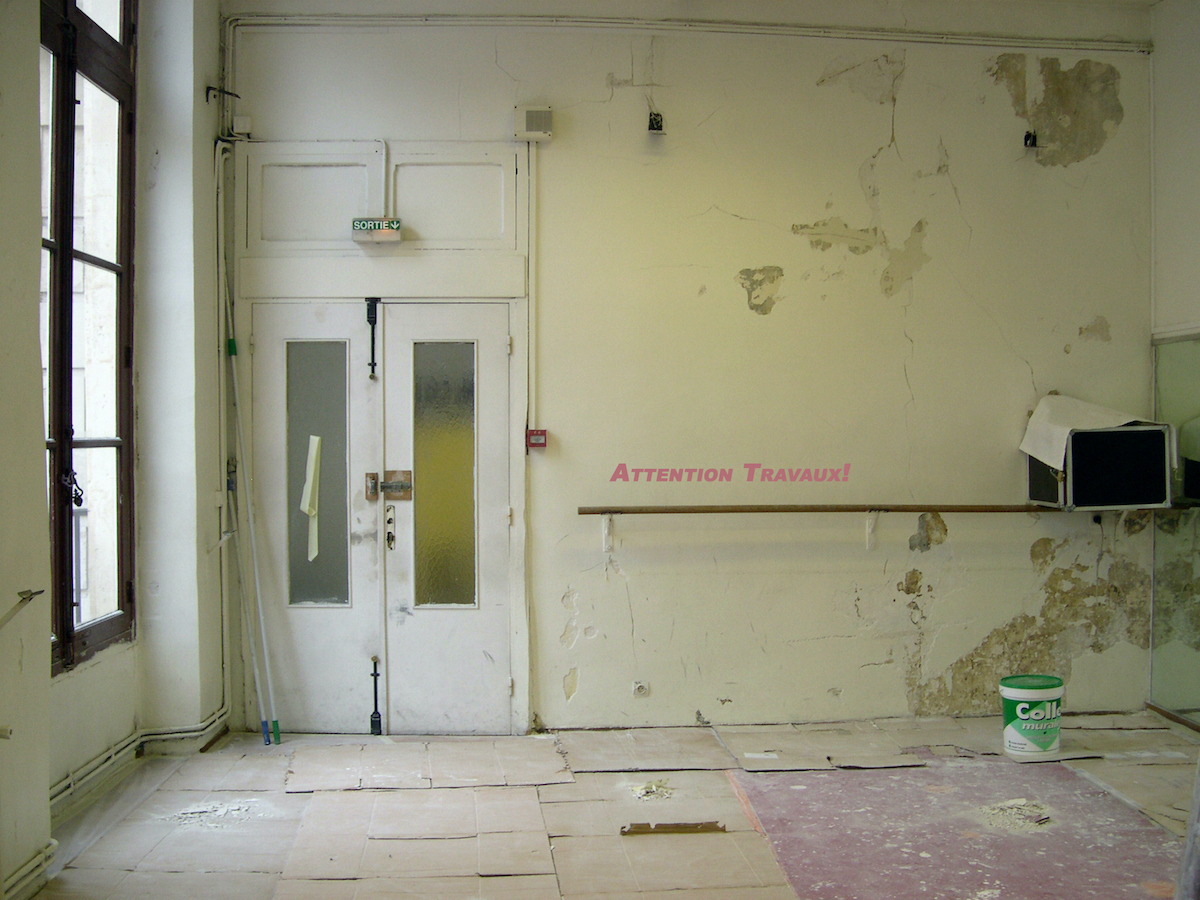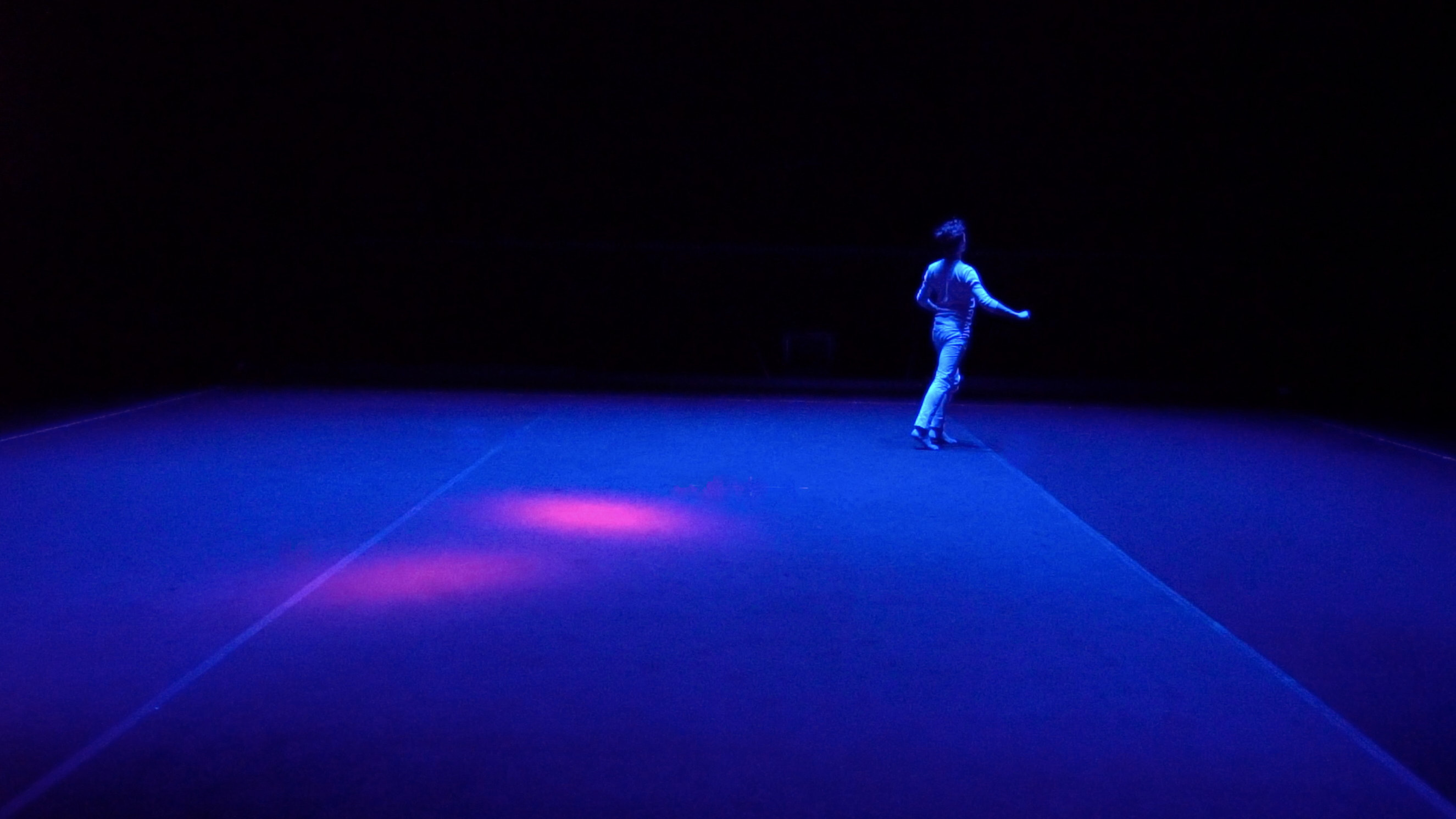Looking back on my past art residency experiences, they could be roughly divided into two types. One was when I found myself struggling with a career bottleneck, hoping to take a rest to help my body and mind recover. The other was to look forward to breaking through my habituated creating methods, challenging the unknown, and expanding my horizons. No matter what motivation set me out, what I gained from art residency was always beyond my expectations. Art-making has given me incredible life adventures. And the art residency experiences has been nourished me until now.
2007: The Cité Internationale des Arts/ Micadanses, France
 Invitation of the Open studio Village of Cité Internationale des Arts: the photo shows a dance studio in a 17th-century building under construction.
Invitation of the Open studio Village of Cité Internationale des Arts: the photo shows a dance studio in a 17th-century building under construction.
In 2007, I applied for the Cultural Exchange Program of the Ministry of Culture of Taiwan for a six-month residency at the Cité Internationale des Arts in Paris, France. At that time, I wanted to slow down my pace to ponder the possibilities of choreography and figure out how artists interpret their feelings. Nonetheless, there was no private rehearsal room at the Cité Internationale des Arts, so the staff of Cité referred me to Micadanses Dance Center. The center provides regular dance classes. It also offers opportunities for the choreographers and dancers to rehearse or present their works there.
The most memorable experience during my residency in Paris was that I had a lot of time to improvise alone or merely write down my feelings in tranquility rather than being occupied by busy rehearsing schedules as usual. Sometimes when I looked at the empty rehearsal room, I thought this would be my canvas if I had been a painter because dance is transient, and what is left is within the body. Rather than being anxious, I enjoyed the growth of my inner energy while creating loneliness.
To get acquainted with other artists in the residency, I offered regular relaxation classes. The classes attracted many musicians and writers to relax their bodies and minds after a long day of work. We usually stayed and chatted for a while after class. We shared stories about our lives at the Cité and visited each other on Open Studio. There was an Australian writer I made friends with at the Cité. She used to write in the morning and dressed up for walks in the evening. We often strolled along the Seine after dinner. She was working on a semi-autobiographical novel that contained intimate subjects at that time. So we discussed female artists' complexities and how to balance our bodies and emotions when creating. We encouraged each other to look closely into the "language" of the body, no matter how subtle or uncomfortable it could be. Such a conversation with other residency artists was extremely precious to me by then.
2016: The European Organization for Nuclear Research / Arts@CERN
 Guided tour of the ATLAS experiment by scientist Steven Goldfarb.
Guided tour of the ATLAS experiment by scientist Steven Goldfarb.
The European Organization for Nuclear Research (CERN) is in Geneva, Switzerland. It is the world's largest particle physics laboratory and the birthplace of the World Wide Web. My expectation of experiencing art in a non-conventional artistic context motivated me to apply for the residency with CERN. Initially, I was worried that it would be a challenging journey because I did not understand scientists' logic and working habits. However, during my six-week residency, a staff patiently took me to visit laboratories, invited me to have meals and meetings with scientists, to join art activities together, and gave me a reading list to understand relative science topics more. The step-by-step process was beyond my expectation of art residency.
 ATLAS is one of the seven experimental detectors equipped with the Large Hadron Collider (LHC).
ATLAS is one of the seven experimental detectors equipped with the Large Hadron Collider (LHC).
 To be a observer in a science workshop .
To be a observer in a science workshop .
Arts@CERN gave artists time to observe their surroundings and to experience science with artistic thinking. It enhanced the equality of conversation between art and science. Although I was not familiar with science, getting along with scientists helped us to cross the barrier of professional difference.
I remember several physicists mentioned the concept of "scale." They explained profound theories in simple language in describing the timeline and the state of the world from the Big Bang to the present time. They explained the laws of matter, nature, and celestial bodies from the scales of the universe to the quantum world. These concepts led me to redefine my definition of creativity, technology, and science. I started to appreciate how physicists, mathematicians, and astronomers conceive arts and beauty.
 The Alpha Magnetic Spectrometer (AMS) is a particle physics experimental facility installed on the International Space Station. It was impressive to meet Dr. Samuel Chao Chung Ting, the program host.
The Alpha Magnetic Spectrometer (AMS) is a particle physics experimental facility installed on the International Space Station. It was impressive to meet Dr. Samuel Chao Chung Ting, the program host.
Sometimes, we could be beginners in unfamiliar fields, but in art, we could be free from rules because there would always be new solutions to problems in the art. It is why art is so interesting. Although the logic of art seemed to contradict science, countless astonishing artworks were born under the conversation between scientists and artists.
2019-2020: EMPAC / Curtis R. Priem Experimental Media and Performing Arts Center, Rensselaer Polytechnic Institute, Troy, NY
 Presenting parts of my work to the invited guests.
Presenting parts of my work to the invited guests.
EMPAC is located in New York State, the USA, which commits to experimental media, production, and performing arts research. The institution has three departments: Performing Arts, Music/Sound, and Moving Image. Johannes Goebel, the founder of the Music/Sound department of ZKM Media Art Center in Germany, led the initial design of the EMPAC. His design, from space to personnel planning, all considered experimental media performing artists' needs, emphasizing the importance of science and technology.
 Director Johannes Goebel guided us around the Concert Hall.
Director Johannes Goebel guided us around the Concert Hall.
By invitation, the artist residency program of EMPAC requests for onsite creations. Therefore, the curator will invite the artists and develop residency plans with them.
On my first visit, I attended EMPAC's annual Audio Summer Seminar. I saw their audio-visual productions as well as the sharing and try-out of technicians, artists, and scholars. I am always fascinated by sound, perhaps because sound and dance are abstract. Both could shape an imaginary time and space, which allows the body and consciousness to wander in.
On the second visit, I went with the Taiwanese production team after deciding on my sound experiment project. And EMPAC assisted me in developing my next new project.
 Working photo, from left to right: American choreographer/dancer Adam Weinert, Taiwanese sound artist Ping- Sheng Wu, Taiwanese new media artist Huei-Ming Chang, American sound artist Bobby McElver, me, and Taiwanese new media artist Wei-Hsuan Huang.
Working photo, from left to right: American choreographer/dancer Adam Weinert, Taiwanese sound artist Ping- Sheng Wu, Taiwanese new media artist Huei-Ming Chang, American sound artist Bobby McElver, me, and Taiwanese new media artist Wei-Hsuan Huang.
EMPAC was good at assisting artists in evaluating production schedules. They also had a high standard on the quality of sound and technic. The staff had already taken care of what I was fussy about, such as the projector noise, exit light, and the floor reflections. During the working process, I was amazed by the efficiency of this professional team. They not only offered practical suggestions but also respected the artistic experimental attempt and valued the process rather than the outcome, which reassured me when facing the unknown.
Our team worked at The Goodman Studio/Theater, making technical corrections and preparations for sound, lighting, video, and dance.
As an artist, the way of pursuing inspiration varies at different stages. Sometimes we need stimulations and cultural clashes to intensify our creativity desire; sometimes, we need to calm our minds to put feelings into creativity; and sometimes, we bump into opportunities simply by meeting different people.
Art residencies empowered artists by allowing us to explore different paths of creation. Somehow the process of artistic exploring becomes art creation itself. And I believe art residencies will become even more flourished after the epidemic in the coming future.
References:
Grants | Ministry of Culture Taiwan:
https://grants.moc.gov.tw/Web/index.jsp
Cité Internationale des Arts
https://www.citedesartsparis.net/
Micadanses: http://micadanses.com/
SU Wen-Chi presents a VR world imagining gravity through dance | CERN: https://arts.cern/article/su-wen-chi-presents-vr-world-imagining-gravity-through-dance
Artist Residency - Su Wen-Chi | EMPAC: https://empac.rpi.edu/program/curatorial/residencies/2019/su-wen-chi
Author: SU Wen-Chi
Edited: Brix

